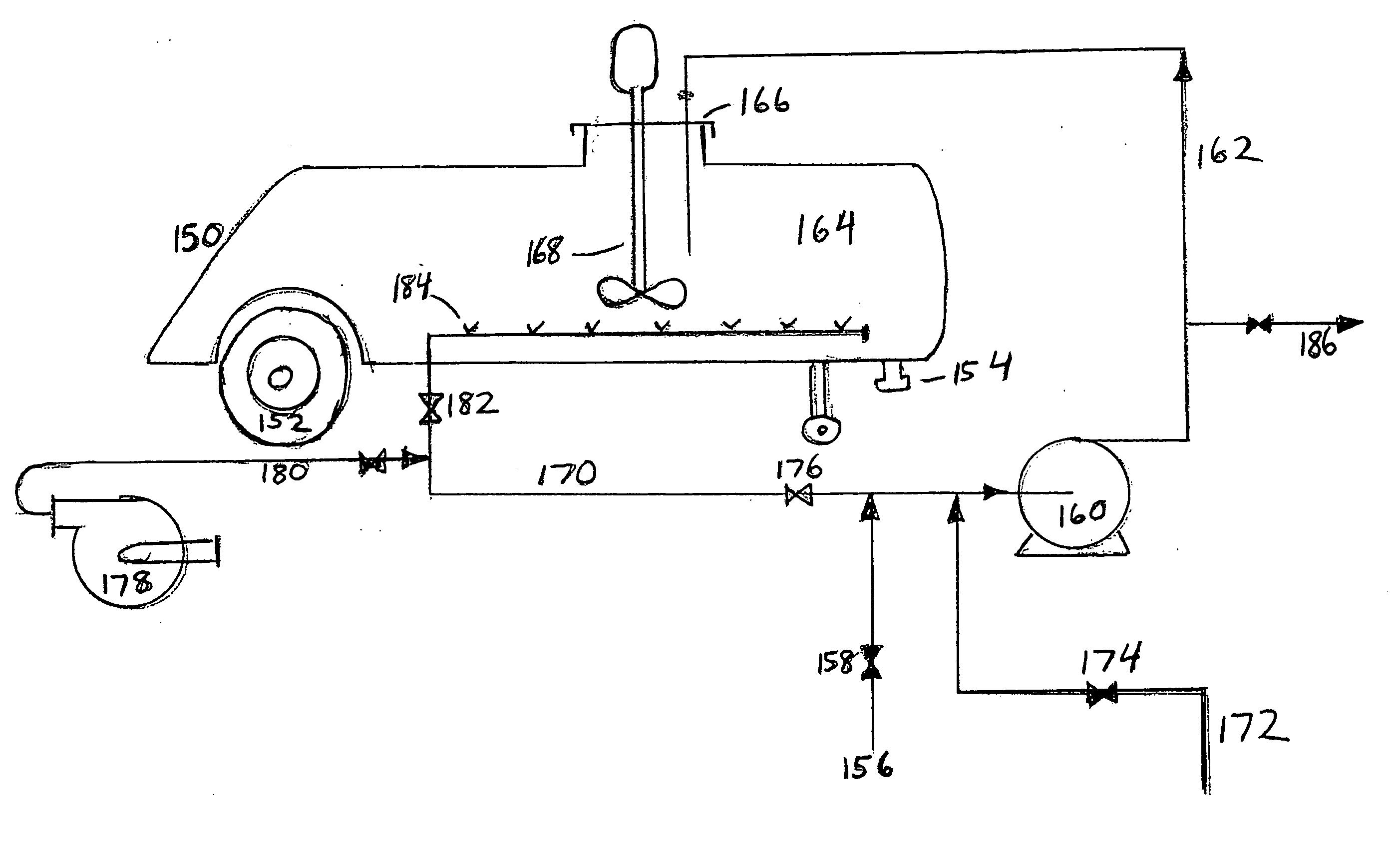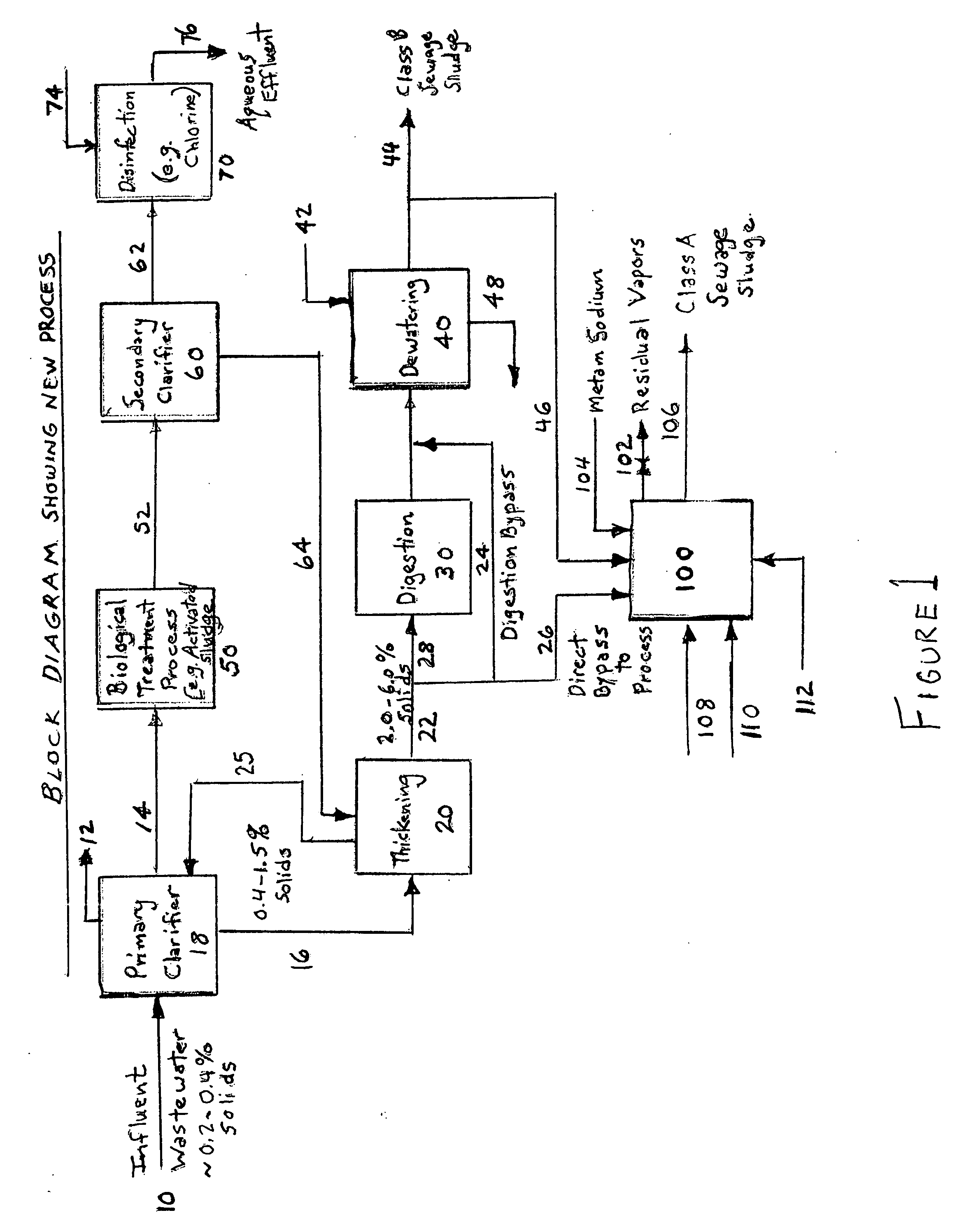Process for disinfection of sewage sludge
a technology for sewage sludge and disinfection equipment, which is applied in the direction of filtration separation, specific water treatment objectives, and separation processes, etc., can solve the problems of sewage sludge generation, large problem in most parts of the world, and unpleasant odor of sewage sludge, and achieve the effect of dissolving residual methyl isothiocyanate and enhancing the removal of any residual methyl isothiocyana
- Summary
- Abstract
- Description
- Claims
- Application Information
AI Technical Summary
Benefits of technology
Problems solved by technology
Method used
Image
Examples
example 1
[0046] Table 1 summarizes the conditions and results of tests in which samples of primary sewage sludge and digested sewage sludge were spiked with viable helminth ova at an approximate dose of greater than 300-400 ova per 4 grams of dry solids. The spiked sewage sludge samples were then treated with metam sodium at a rate of either 3 or 5 gallons per dry short ton of sewage sludge. Treatment was usually carried out in 15 ml cylindrical plastic screw-capped tubes to insure that the containers were closed. Mixing was effected using a magnetic stirring bar where the sample density permitted, and with a VirTis homogenizer for thicker samples. Larger volume samples were tested in closed beakers or flasks equipped with an electrically or pneumatically driven agitator. Sewage sludge temperature was normally 50°-70° F. during treatment. The treatment time listed in Table 1 represents the period of time during which the sample was kept sealed in the tube after addition of metam sodium to th...
example 2
[0047] Table 2 summarizes the conditions and results of tests utilizing samples of primary sewage sludge and digested sewage sludge that were spiked with poliovirus at an approximate density of 1.22×105 plaque-forming units (pfu) per 4 grams of dry solids. The samples were mixed with doses of metam sodium at the equivalent gallons per ton of sewage sludge (dry weight basis) as listed in the table below and after mixing remained in a closed container for the number of hours shown in the table. The density of enteric virus after treatment was determined by analyzing a sample of the treated sewage sludge using a required analytical method (i.e. ASTM D4994-89).
[0048] The results are as follows:
TABLE 2Enteric virusMetamMixingdensitySewagesodiumPeriodTreatment(afterSludge type% solidsDose1(minutes)time (hrs)Temp. (° F.)treatment)Primary2515450Primary8515470Primary1535470Primary3035470Digested2515470Digested8515470Digested1535470Digested3035470
1Gallon per short ton of sewage sludge (dry...
example 3
[0049]Salmonella sp. bacteria were spiked into samples of primary and digested sewage sludge. The density of the Salmonella typhimurium spiking suspension was 1.2×107 cfu / gram. Samples were treated with metam sodium in the same fashion as in the previous examples, with the following results obtained:
TABLE 3sp. densityMetamMixing(afterSewagesodiumPeriodTreatmenttreatment;Sludge type% solidsdose1(minutes)time (hrs)Temp. (° F.)dry basis)primary8515470primary1535470primary3035470digested8515470digested1535470digested2515460primary2515460
1Gallons per short ton of sewage sludge (dry weight basis)
[0050]“MPN” refers to most probable number. The MPN technique is based on a statistical analysis of the number of positive and negative results obtained when testing multiple portions of equal volumes (i.e. multiple samples). The MPN is not an absolute concentration, but only a statistical estimate of the density of microorganisms present.
PUM
| Property | Measurement | Unit |
|---|---|---|
| temperature | aaaaa | aaaaa |
| length of time | aaaaa | aaaaa |
| time | aaaaa | aaaaa |
Abstract
Description
Claims
Application Information
 Login to View More
Login to View More - R&D
- Intellectual Property
- Life Sciences
- Materials
- Tech Scout
- Unparalleled Data Quality
- Higher Quality Content
- 60% Fewer Hallucinations
Browse by: Latest US Patents, China's latest patents, Technical Efficacy Thesaurus, Application Domain, Technology Topic, Popular Technical Reports.
© 2025 PatSnap. All rights reserved.Legal|Privacy policy|Modern Slavery Act Transparency Statement|Sitemap|About US| Contact US: help@patsnap.com



